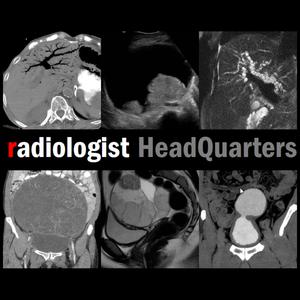
Radiology Lectures | Radiologist Headquarters
Daniel J. Kowal, MD
Radiology Lectures & Quizzes
- 11 minutes 10 secondsUltrasound of Hydrosalpinx, Pyosalpinx & Tubo-ovarian Abscess
Ultrasound of Hydrosalpinx, Pyosalpinx & Tubo-ovarian Abscess
In this radiology lecture, we review the ultrasound appearance of hydrosalpinx, pyosalpinx and tubo-ovarian abscess!
Key teaching points include:
- Hydrosalpinx = Fluid-filled, blocked fallopian tube
- Hydrosalpinx causes: Pelvic inflammatory disease (most common), endometriosis, prior surgery, adhesions
- Hydrosalpinx US: Thin-walled, tubular structure filled with anechoic simple fluid. Dilated tube may fold upon itself forming tubular C-shaped or S-shaped cystic mass. Incomplete septations common
- With chronic hydrosalpinx, may see “beads-on-a-string” sign: Short, round, 2-3 mm projections seen along inner tubal walls in cross section = Flattened, fibrotic remnants of endosalpingeal folds. Don’t confuse with solid mural nodules
- O-RADS US v2022 management of hydrosalpinx = Imaging: None. Clinical: Gynecologist
- Pyosalpinx: Inflamed, blocked fallopian tube filled with purulent debris. Indicates pelvic inflammatory disease
- Pyosalpinx US: Thick-walled tubal structure filled with complex fluid. Like hydrosalpinx, typically conforms to a C or S-shape
- “Cogwheel” sign of pyosalpinx: Thickened endosalpingeal folds with surrounding tubal wall thickening. Typical of acute tubal inflammation
- Tubal wall hyperemia more common with pyosalpinx than hydrosalpinx
- Tubo-ovarian complex (TOC): With severe salpingo-oophoritis, ovary and tube adhere to each other. Can distinctly identify ovary from tube but cannot separate the two with transducer pressure. Tx: Antibiotics
- Tubo-ovarian abscess (TOA): As pelvic inflammatory disease progresses, complete or near-complete loss of adnexal architecture with pockets of purulent fluid develop. Multiloculated mass with septations, irregular margins, may be bilateral. Tx: Antibiotics, percutaneous drainage, surgery
To learn more about the Samsung RS85 Prestige ultrasound system, please visit: https://www.bostonimaging.com/rs85-prestige-ultrasound-system-4
Click the YouTube Community tab or follow on social media for bonus teaching material posted throughout the week!
Spotify: https://spoti.fi/462r0F2
Instagram: https://www.instagram.com/Radquarters/
Facebook: https://www.facebook.com/Radquarters/
X (Twitter): https://twitter.com/Radquarters
Reddit: https://www.reddit.com/user/radiologistHQ/The post Ultrasound of Hydrosalpinx, Pyosalpinx & Tubo-ovarian Abscess appeared first on Radquarters.
12 December 2024, 10:00 am - 8 minutes 2 secondsUltrasound of Gallbladder Adenomyomatosis
In this radiology lecture, we review the ultrasound appearance of adenomyomatosis of the gallbladder!
Key teaching points include:
- Common cause of benign gallbladder wall thickening seen in up to 9% of patients
- Incidence increases with age
- Usually asymptomatic, but may be associated with sporadic RUQ pain
- Hyperplastic changes of gallbladder wall with mucosal overgrowth. Mucosal herniations protrude into muscular layer forming tiny, bile-filled cystic spaces = Rokitansky-Aschoff sinuses
- If large, sinuses may appear as discrete cystic spaces in gallbladder wall
- Cholesterol crystals in sinuses cause comet-tail reverberation artifact: Most common finding and highly specific for adenomyomatosis. Can exaggerate comet-tail with addition of color Doppler
- Three types: Focal/fundal, segmental/annular and diffuse. Regardless of type, comet-tail artifacts and/or cystic spaces are key to diagnosis
- Focal/fundal type: Most common. Often exhibits an “ovary on the gallbladder” appearance. Can be confused with a gallbladder mass. High-frequency linear transducer may be helpful to identify morphology
- Segmental/annular type: Narrows waist of gallbladder yielding a figure 8 or hourglass configuration. Gallstones and/or sludge often form in proximal lumen due to increased stasis
- If necessary, MRI helpful for problem solving: T2 hyperintense pearl necklace/string of beads appearance sensitive and specific
To learn more about the Samsung RS85 Prestige ultrasound system, please visit: https://www.bostonimaging.com/rs85-prestige-ultrasound-system-4
Click the YouTube Community tab or follow on social media for bonus teaching material posted throughout the week!
Spotify: https://spoti.fi/462r0F2
Instagram: https://www.instagram.com/Radquarters/
Facebook: https://www.facebook.com/Radquarters/
X (Twitter): https://twitter.com/Radquarters
Reddit: https://www.reddit.com/user/radiologistHQ/The post Ultrasound of Gallbladder Adenomyomatosis appeared first on Radquarters.
17 October 2024, 9:00 am - 8 minutes 58 secondsUltrasound of de Quervain’s Tenosynovitis
In this radiology lecture, we review the ultrasound appearance of de Quervain’s Tenosynovitis!
Key teaching points include:
- Stenosing tenosynovitis of first extensor compartment tendons = Extensor pollicis brevis (EPB) and abductor pollicis longus (APL)
- Second most common hand entrapment tendinopathy after trigger finger
- Most common in middle-aged females
- Associations include repetitive hand motions, pregnancy, arthritis, and trauma
- Clinical presentation: Pain with thumb and wrist movement, tenderness and swelling at radial styloid
- Positive Finkelstein maneuver may be present: Grasp thumb, ulnar deviate hand = Pain over distal radius
- Ultrasound findings: Increased fluid in EPB/APL tendon sheath (tenosynovitis), hypoechoic, edematous tendon thickening (tendinosis), and thickening of extensor retinaculum (comparison scanning of contralateral thumb helpful)
- Advanced findings: Impaired tendon movement, tendon tear (anechoic clefts), retinacular and peritendinous hyperemia
- Don’t confuse normal APL slips with longitudinal tear (“lotus root” sign)
- Important to identify variant intertendinous septa: Helps to properly guide steroid injection, increased incidence of asymmetric EPB involvement
- If conservative therapy fails, surgical decompression may be required. More likely when septum present
To learn more about the Samsung RS85 Prestige ultrasound system, please visit: https://www.bostonimaging.com/rs85-prestige-ultrasound-system-4
Click the YouTube Community tab or follow on social media for bonus teaching material posted throughout the week!
Spotify: https://spoti.fi/462r0F2
Instagram: https://www.instagram.com/Radquarters/
Facebook: https://www.facebook.com/Radquarters/
X (Twitter): https://twitter.com/Radquarters
Reddit: https://www.reddit.com/user/radiologistHQ/The post Ultrasound of de Quervain’s Tenosynovitis appeared first on Radquarters.
12 September 2024, 9:00 am - 10 minutes 3 secondsContrast-Enhanced Ultrasound of Hemangioma
In this radiology lecture, we review the contrast-enhanced ultrasound appearance of hepatic hemangioma!
Key teaching points include:
- Microbubble contrast agents are gas-filled microspheres with a lipid or protein shell
- Sulfur hexafluoride lipid-type A microspheres: Inert gas of six fluoride atoms bound to one sulfur atom, surrounded by a phospholipid shell
- Similar in size to red blood cells, unique when compared to the molecular sizes of CT and MR imaging contrast agents. Small enough to cross capillary beds, too large to enter interstitial space = Pure intravascular agents, ideal for assessing vascularity and perfusion
- After IV injection, US contrast agents half-life is about 10 minutes (eliminated via lungs). Multiple injections possible in a single session
- Contrast-enhanced US (CEUS) has high contrast resolution: Can visualize individual microbubbles and depict a minute amount of flow = Differentiate avascular debris from small solid nodules in complex cysts. Negative predictive value of CEUS in excluding the presence of flow in a lesion is close to 100%
- CEUS also has high temporal resolution: Effectively eliminates motion artifact, a major source of artifact on CT and especially MRI scans. In elderly or debilitated patients, or when there is any other cause of motion, CEUS may be the contrast-enhanced modality of choice
- Accuracy and specificity of CEUS for the diagnosis of hepatic hemangioma approaches 100%
- Mechanical index (MI) = Measure of acoustic power output. At high MI, microbubbles burst. At low MI, microbubbles are preserved and have a nonlinear response to US, unlike other tissues which have a linear response. Allows for creation of a vascular-only image
- Hemangioma has peripheral discontinuous globular enhancement in arterial phase. Progressive centripetal contrast filling and iso- or hyperenhancement in portal venous and late phase
- Non-hepatocellular malignancy typically demonstrates early (less than 1 minute) and/or marked washout
- Hemangioma filling may be partial or complete depending on lesion size
To learn more about the Samsung RS85 Prestige ultrasound system, please visit: https://www.bostonimaging.com/rs85-prestige-ultrasound-system-4
See more impressive visuals by filmmaker and freelance motion graphics artist Nick Shaheen: https://www.instagram.com/nickhshaheen
Click the YouTube Community tab or follow on social media for bonus teaching material posted throughout the week!
Spotify: https://spoti.fi/462r0F2
Instagram: https://www.instagram.com/Radquarters/
Facebook: https://www.facebook.com/Radquarters/
X (Twitter): https://twitter.com/Radquarters
Reddit: https://www.reddit.com/user/radiologistHQ/The post Contrast-Enhanced Ultrasound of Hemangioma appeared first on Radquarters.
15 August 2024, 9:00 am - 9 minutes 20 secondsUltrasound of Tennis Leg
In this radiology lecture, we review the ultrasound appearance of tennis leg, including medial gastrocnemius and plantaris injury!
Key teaching points include:
- Tennis leg = Injury to muscles of the calf. Tear of myotendinous junction of medial head of gastrocnemius, rupture of plantaris tendon (less common), in isolation or together
- Classically described in tennis players, but can occur in various athletic activities (running, skiing) with extension of knee and forced dorsiflexion of ankle. Typically seen in middle-aged, active individuals
- Clinical: Sudden sharp calf pain with associated popping/snapping sensation followed by tenderness and swelling
- Gastrocnemius & soleus are pennate muscles. Fascicles attach obliquely to a tendon = Aponeuroses with long length of musculotendinous junction. Feathers converging on a single point
- Triceps surae muscle = Two headed gastrocnemius, soleus and plantaris. Distal continuation of the gastrocnemius and soleus forms the Achilles tendon
- Distal medial head of gastrocnemius where tapers over soleus = One of most commonly injured calf structures
- Medial gastrocnemius tear appears as disrupted tendon fibers at aponeurosis with anechoic/hypoechoic fluid or hemorrhage +/- muscle retraction
- May see retracted muscle fascicles. Hematoma can dissect between and extends into medial gastrocnemius and soleus muscles
- Tx: Conservative (self-limiting). Surgical fasciotomy if compartment syndrome
- Plantaris muscle arises from the posterosuperior aspect of lateral femoral condyle near lateral head origin of gastrocnemius muscle. Medially crosses posterior knee joint in oblique fashion
- Plantaris continues into calf as a long, thin tendon traveling between medial head of gastrocnemius and soleus muscles. Courses distally at medial aspect of Achilles tendon, usually inserts onto calcaneus. Plantaris is absent in up to 20%
- Plantaris injury/rupture less common than medial head gastrocnemius tear and typically more proximal in calf (at myotendinous junction)
To learn more about the Samsung RS85 Prestige ultrasound system, please visit: https://www.bostonimaging.com/rs85-prestige-ultrasound-system-4
Click the YouTube Community tab or follow on social media for bonus teaching material posted throughout the week!
Spotify: https://spoti.fi/462r0F2
Instagram: https://www.instagram.com/Radquarters/
Facebook: https://www.facebook.com/Radquarters/
X (Twitter): https://twitter.com/Radquarters
Reddit: https://www.reddit.com/user/radiologistHQ/The post Ultrasound of Tennis Leg appeared first on Radquarters.
14 July 2024, 9:00 am - 7 minutes 50 secondsUltrasound of Interstitial Ectopic Pregnancy
In this radiology lecture, we review the ultrasound appearance of interstitial ectopic pregnancy!
Key teaching points include:
- Interstitial ectopic pregnancies are rare, occurring in proximal (interstitial) portion of fallopian tube within muscle wall of uterus
- Much less common than tubal ectopic pregnancy occurring in the more distal ampullary and isthmic portions of fallopian tube
- Interstitial ectopic pregnancies are important because higher morbidity and mortality due to later presentation and risk of life-threatening hemorrhage
- Abnormally eccentric gestational sac with thin surrounding myometrium: less than 5 mm myometrial thickness highly suspicious
- “Interstitial line” sign: Thin echogenic line extending from endometrial cavity to ectopic gestational sac. Thought to represent interstitial portion of tube separating the ectopic pregnancy from the endometrium
- Medical: Systemic MTX, may also be injected into gestational sac
- Surgery: Cornual wedge resection when ruptured versus hysterectomy
- Can be confused with angular pregnancy: Rare, intrauterine pregnancy with implantation eccentrically high at the lateral angle of uterine cavity. More medial than interstitial ectopic pregnancies. No interstitial line sign, and greater than 5 mm thickness of overlying myometrial mantle
- Angular pregnancy can result in normal pregnancy, but increased risk of miscarriage and uterine rupture. Should be followed closely to ensure growth towards endometrial cavity
- Angular pregnancy is sometimes referred to as a “cornual pregnancy,” but controversial as earliest use of term cornual pregnancy refers to intrauterine implantations in anomalous unicornuate, bicornuate or septate uteri. To avoid confusion, best to specifically describe whether the gestational sac is intrauterine or ectopic
To learn more about the Samsung RS85 Prestige ultrasound system, please visit: https://www.bostonimaging.com/rs85-prestige-ultrasound-system-4
Click the YouTube Community tab or follow on social media for bonus teaching material posted throughout the week!
Spotify: https://spoti.fi/462r0F2
Instagram: https://www.instagram.com/Radquarters/
Facebook: https://www.facebook.com/Radquarters/
X (Twitter): https://twitter.com/Radquarters
Reddit: https://www.reddit.com/user/radiologistHQ/The post Ultrasound of Interstitial Ectopic Pregnancy appeared first on Radquarters.
6 June 2024, 9:00 am - 6 minutes 52 secondsUltrasound of Ovarian Serous Cystadenocarcinoma
In this radiology lecture, we review the ultrasound appearance of ovarian serous cystadenocarcinoma!
Key teaching points include:
- Serous cystadenocarcinoma is the common ovarian malignancy and most common ovarian epithelial tumor
- High-grade and low-grade types
Peak incidence 6th-7th decades - Ultrasound appearance: Mixed cystic and solid mass with papillary projections and thick septations
- Elevated CA-125 in greater than 90%
- Serous tumors are more commonly bilateral than other tumors
- Four main categories of ovarian neoplasms: Epithelial (most common), germ cell (second most common), sex cord-stromal and metastases
- Epithelial ovarian tumors are thought to originate outside the ovary (within fallopian tube or endometrium) and involve ovary secondarily
- Epithelial ovarian tumor types: Serous, mucinous, endometrioid, clear cell and Brenner
- 60% of epithelial tumors are benign: Unilocular with thin wall or thin septations (less than 3 mm in thickness)
- 40% of epithelial tumors are malignant or borderline: Papillary projection (distinctive feature of epithelial tumors) with thick, irregular wall or septations (greater than 3 mm in thickness). Can also present as a large soft tissue mass with necrosis. Advanced findings include peritoneal implants, pelvic wall invasion, adenopathy and ascites
To learn more about the Samsung RS85 Prestige ultrasound system, please visit: https://www.bostonimaging.com/rs85-prestige-ultrasound-system-4
Click the YouTube Community tab or follow on social media for bonus teaching material posted throughout the week!
Spotify: https://spoti.fi/462r0F2
Instagram: https://www.instagram.com/Radquarters/
Facebook: https://www.facebook.com/Radquarters/
X (Twitter): https://twitter.com/Radquarters
Reddit: https://www.reddit.com/user/radiologistHQ/The post Ultrasound of Ovarian Serous Cystadenocarcinoma appeared first on Radquarters.
2 May 2024, 9:00 am - 6 minutes 37 secondsUltrasound of Parathyroid Adenoma
In this radiology lecture, we review the ultrasound appearance of parathyroid adenoma!
Key teaching points include:
- Benign tumor of the parathyroid glands
- Most common cause of primary hyperparathyroidism: Elevated serum calcium and parathyroid hormone (PTH) levels
- Ultrasound: Solid, homogeneous and very hypoechoic. Oval or bean-shaped, long axis oriented craniocaudal. Hypervascular. Majority posterior and inferior to thyroid. Hyperechoic line often separates adenoma from adjacent thyroid. Atypical features: Cystic degeneration, calcification.
- Tc-99m sestamibi: Radiotracer uptake persisting on delayed 2-hour images. Taken up by both thyroid and parathyroid tissue, but washes out more rapidly from thyroid. Greater than 90% predictive value for preoperative localization of parathyroid adenoma. SPECT aids with anatomic localization
- Ectopic locations in up to 5%: Lower neck, mediastinum, retrotracheal/retroesophageal, carotid sheath and intrathyroidal (typically more homogeneous than thyroid nodules and have a linear interface with gland)
- Larger adenomas can be multilobulated
- “Polar vessel” sign: Enlarged feeding artery or draining vein terminating at parathyroid adenoma
To learn more about the Samsung RS85 Prestige ultrasound system, please visit: https://www.bostonimaging.com/rs85-prestige-ultrasound-system-4
Click the YouTube Community tab or follow on social media for bonus teaching material posted throughout the week!
Spotify: https://spoti.fi/462r0F2
Instagram: https://www.instagram.com/Radquarters/
Facebook: https://www.facebook.com/Radquarters/
X (Twitter): https://twitter.com/Radquarters
Reddit: https://www.reddit.com/user/radiologistHQ/The post Ultrasound of Parathyroid Adenoma appeared first on Radquarters.
4 April 2024, 9:00 am - 6 minutes 13 secondsUltrasound of Parotitis
In this radiology lecture, we review the ultrasound appearance of parotitis in the pediatric population!
Key teaching points include:
- Parotitis = Inflammation of the parotid glands
- Acute parotitis is usually infectious, most commonly viral
- Mumps is most common viral cause in children, often bilateral
- Bacterial parotitis can cause suppurative parotitis seen in premature infants and immunosuppressed children
- Acute parotitis on US: Enlarged, heterogeneous, hyperemic gland(s) +/- lymphadenopathy
- Since can be bilateral, comparison scanning essential
- Bacterial parotitis may be complicated by abscess
- “Pomegranate sign” may be seen in setting of acute parotitis: Uniform anechoic foci scattered throughout the gland
- Juvenile recurrent parotitis (JRP) = Recurrent inflammatory parotitis in children of unknown etiology
- JRP is rare, but second most common cause of parotitis in childhood after mumps
- JRP often begins between age 3-6, typically resolves spontaneously after puberty
- Usually idiopathic, JRP can be presenting symptom of Sjogren’s syndrome, lymphoma, and underlying immunodeficiency
- JRP on US: May be unilateral or bilateral, multiple hypoechoic foci of salivary secretions scattered throughout the gland +/- central calcifications, color Doppler can be normal
- Additional causes of parotitis: Sialolithiasis/obstruction, autoimmune (Sjogren syndrome, chronic sclerosing sialadenitis), infectious (HIV, TB), and sarcoidosis (rare in children).
To learn more about the Samsung RS85 Prestige ultrasound system, please visit: https://www.bostonimaging.com/rs85-prestige-ultrasound-system-4
Click the YouTube Community tab or follow on social media for bonus teaching material posted throughout the week!
Spotify: https://spoti.fi/462r0F2
Instagram: https://www.instagram.com/Radquarters/
Facebook: https://www.facebook.com/Radquarters/
X (Twitter): https://twitter.com/Radquarters
Reddit: https://www.reddit.com/user/radiologistHQ/The post Ultrasound of Parotitis appeared first on Radquarters.
7 March 2024, 10:00 am - 8 minutes 30 secondsUltrasound of Sublingual Dermoid Cyst
In this radiology lecture, we review the ultrasound appearance of sublingual dermoid cyst and explain floor of mouth anatomy!
Key teaching points include:
- The floor of the mouth is a horseshoe-shaped area beneath tongue and in between sides of mandible, inferiorly bounded by mylohyoid muscle, and containing sublingual space (SLS)
- SLS medial border: Midline genioglossus/geniohyoid muscle complex; SLS inferolateral border: Mylohyoid muscle
- Anterior margin of hyoglossus muscle projects into posterior SLS
- Sublingual dermoid cyst is a rare, benign cyst with squamous epithelial lining and contains skin appendages
- Dermoid and epidermoid cysts are in same family, terminology often used interchangeably, although epidermoid cysts less common and tend to contain fluid contents only
- Dermoid cyst mean age of presentation late teens to twenties, average age 30
- Presents as a slowly enlarging neck mass, may cause dysphagia
- Often round or oval in shape and homogeneously hypoechoic with punctate echogenic foci
- May have pathognomonic “sack of marbles” appearance
- Relationship to mylohyoid is key for surgical planning: Intraoral resection for sublingual (above mylohyoid) location, extraoral approach for submental/submandibular (below mylohyoid) location
- Most cysts are midline
- DDx: Suprahyoid thyroglossal duct cyst, ranula (simple and diving), abscess and lymphangioma
To learn more about the Samsung RS85 Prestige ultrasound system, please visit: https://www.bostonimaging.com/rs85-prestige-ultrasound-system-4
Click the YouTube Community tab or follow on social media for bonus teaching material posted throughout the week!
Spotify: https://spoti.fi/462r0F2
Instagram: https://www.instagram.com/Radquarters/
Facebook: https://www.facebook.com/Radquarters/
X (Twitter): https://twitter.com/Radquarters
Reddit: https://www.reddit.com/user/radiologistHQ/The post Ultrasound of Sublingual Dermoid Cyst appeared first on Radquarters.
8 February 2024, 10:00 am - 9 minutes 57 secondsUltrasound of Carpal Tunnel Syndrome
In this radiology lecture, we review the ultrasound appearance of carpal tunnel syndrome!
Key teaching points include:
- Most common upper extremity entrapment neuropathy. Results from median nerve compression
- With carpal tunnel syndrome, see hypoechoic enlargement of the median nerve as enters carpal tunnel with flattening of nerve = Notch sign, also volar bowing of flexor retinaculum
- Median nerve area: Less than 8 mm2 = Normal; 8-12 mm2 = Borderline; greater than 12 mm2 = Abnormal
- Most accurate to compare nerve area at proximal pronator quadratus muscle and carpal tunnel: Increase of 2 mm2 or more from proximal to distal = 99% sensitive and 100% specific for carpal tunnel syndrome. Measure inside the echogenic epineurium
- Bifid median nerve: Normal variant in 15% of population, one trunk may take aberrant course through flexor digitorum superficialis musculature, and often associated with persistent median artery between the two trunks
- Important to recognize persistent median artery pre-operatively because could be damaged during surgery
- For diagnosis of carpal tunnel syndrome with bifid median nerve: Combined increase of 4 mm2 or more
- After carpal tunnel release surgery, median nerve may return to normal diameter or remain enlarged regardless of clinical outcome. Retinaculum may appear thickened or disrupted
- Carpal tunnel syndrome can be caused by extrinsic compression by a mass, ganglion cyst, or tenosynovitis
Reference: Klauser AS, Halpern EJ, De Zordo T, et al. Carpal tunnel syndrome assessment with US: value of additional cross-sectional area measurements of the median nerve in patients versus healthy volunteers. Radiology. 2009;250(1):171-177.
To learn more about the Samsung RS85 Prestige ultrasound system, please visit: https://www.bostonimaging.com/rs85-prestige-ultrasound-system-4
Click the YouTube Community tab or follow on social media for bonus teaching material posted throughout the week!
Spotify: https://spoti.fi/462r0F2
Instagram: https://www.instagram.com/Radquarters/
Facebook: https://www.facebook.com/Radquarters/
Twitter: https://twitter.com/Radquarters
Reddit: https://www.reddit.com/user/radiologistHQ/The post Ultrasound of Carpal Tunnel Syndrome appeared first on Radquarters.
30 October 2023, 9:00 am - More Episodes? Get the App
Your feedback is valuable to us. Should you encounter any bugs, glitches, lack of functionality or other problems, please email us on [email protected] or join Moon.FM Telegram Group where you can talk directly to the dev team who are happy to answer any queries.
 EM Clerkship
EM Clerkship
 White Coat Investor Podcast
White Coat Investor Podcast
 RadioGraphics Podcasts | RSNA
RadioGraphics Podcasts | RSNA
 The Radiology Review Podcast
The Radiology Review Podcast
 Radiology Core Exam Review
Radiology Core Exam Review
 Radiology Podcasts | RSNA
Radiology Podcasts | RSNA